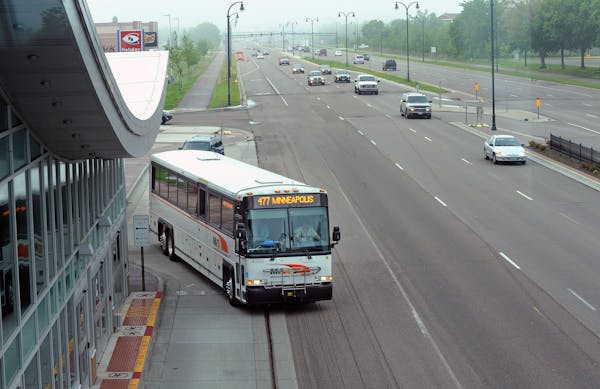Minneapolis is working to make buses move faster on three of the city's most traffic-clogged streets.
The city will put permanent bus-only lanes on portions of Hennepin and Chicago avenues in August and test a bus-only lane on a segment of Nicollet Avenue in south Minneapolis this fall.
The lanes, designed to help keep buses running on time and offer more consistent travel times, will be in effect only during morning and afternoon rush hours, said Becca Hughes, a senior transportation planner with the city's Public Works Department.
"We're excited to make this a reality and try to improve transit mobility," she said.
Motorists won't lose any travel lanes, but some on-street parking will be lost during the commute times when the parking areas become bus lanes, she said.
The decision Tuesday to institute the lanes comes after Metro Transit and the city tried a pilot project in May 2018 to gauge their effectiveness and the city was awarded a grant from the American Cities Climate Challenge to find ways to reduce air pollution and greenhouse gases. As part of the grant, the city was tasked with coming up with three projects. That, combined with efforts to shape the city's 10-year Transportation Action Plan, led to the bus lanes, Hughes said.
Metro Transit had identified Hennepin Avenue south of downtown as needing faster bus service. More than 400 buses use the section of Hennepin between Franklin Avenue and the Uptown Transit Station each weekday. The buses carry more than 3,300 riders a day, but trips are often behind schedule because buses get stuck in traffic.
At times, buses move at only 6 mph, said Metro Transit senior planner Michael Mechtenberg.
"On a good day, northbound traffic flows fine, but on bad days there is a ripple effect and there are severe backups," he said. Crashes on I-94 and winter snows often contribute to traffic snarls. "We are trying to even that out so we don't have those bad days."
About 6% to 7% of travelers in Minneapolis use public transportation to get around, Hughes said. She hopes the bus-only lanes will provide more consistency and entice more people to ride the bus.
On Hennepin, the location of the bus lane will change during the day. From 7 a.m. to 9 a.m., there will be no street parking on the northbound side between Lake Street and the Uptown Transit Station and from 25th Street to Franklin Avenue — keeping that space clear for a bus lane. From 4 p.m. to 6:30 p.m., there will be no parking southbound from Franklin Avenue to 25th Street, and buses will run in that space. Parking will still be allowed when bus lanes are not in effect.
New seal coating and paint markings will be put down to designate the areas that will be used as a bus-only lane, Mechtenberg said.
On southbound Chicago Avenue, a center turn lane at 28th Street will be converted into a bus lane during the evening rush to make it easier for buses to make left turns into the Chicago/Lake Street Transit Center, he said.
The Nicollet pilot project to debut this fall is still being finalized. It will feature a bus-only lane for more hours of the day than on Hennepin because of higher ridership during midday hours, Mechtenberg said. The lane would run from Franklin Avenue to 29th Street, then jog over to Blaisdell Avenue and down to Lake Street.
"We are still trying some things out," Mechtenberg said.
There may be more bus lanes coming to city roads. In 2020, Metro Transit hopes to add similar lanes in north and northeast Minneapolis, Mechtenberg said.

Four Minnesotans catch salmonella in outbreak linked to basil sold at Trader Joe's

Rep. Omar's daughter arrested, suspended from college for pro-Palestinian protests
Hopkins parents charged in 9-year-old daughter's asthma death

Back to blue: Lake Harriet Band Shell renovation almost finished

